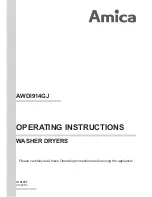
Page EN-32 Installation, connection and initial commissioning
Connecting the inlet hose
NOTICE
Risk of damage to property!
The appliance is designed for a water
pressure of 0.4–10 bar (0.04–1.0 MPa).
Water must always be able to run freely
into the dishwasher, otherwise the ap-
pliance may become damaged.
■
If the water pressure is higher than
this, install a pressure reducer. If in
doubt, enquire about the water pres-
sure with the water supply company.
■
Never connect the appliance to the
water tap or the mixing arm of a wa-
ter heater (continuous flow heater,
pressure-free boiler etc.).
■
Ensure that the inlet hose is not
kinked and is carefully connected.
■
Do not cut through the inlet hose.
It contains electrical components. If
the inlet hose is damaged, have it re-
placed by a specialist (“Service” see
page EN-44).
■
Do not use old or previously installed
inlet hoses.
3
3/4-inch
Inlet hose
For the water supply, you will need a valve
with a 3/4 inch screw connection.
1. Screw the union nut of the inlet
hose (40) hand-tight onto the water tap.
2. Check that the connection to the water
tap is sealed. Turn on the water tap slow-
ly and ensure that no water is escaping.
Then close the tap again.
Connecting the mains plug
WARNING
Risk of electric shock!
Faulty electrical installation or excessive
mains voltage may result in an electric
shock.
■
Prior to connecting the appliance, en-
sure that you have page EN-4 taken
note of all the safety instructions and
adhered to them.
Fire hazard!
Improper handling of the appliance
can lead to fire.
■
Never use multi-socket adapters, mul-
ti-socket strips, travel adapters or the
like.
• Please ensure you only connect the ap-
pliance to a professionally installed pro-
tective contact socket with sufficient fuse
protection (220 – 240 V~/50 Hz/10 A).
• Ensure that the socket is installed in such
a way that the recess for the dishwasher
is deep enough even when the plug is in-
serted.
• Do not use a multi-socket extension ca-
ble, multi-socket plug, travel adapter, ex-
tension cable or similar.
We recommend using a pulse-sensitive
residual current device (RCD).
• Insert the mains plug into the socket.
















































